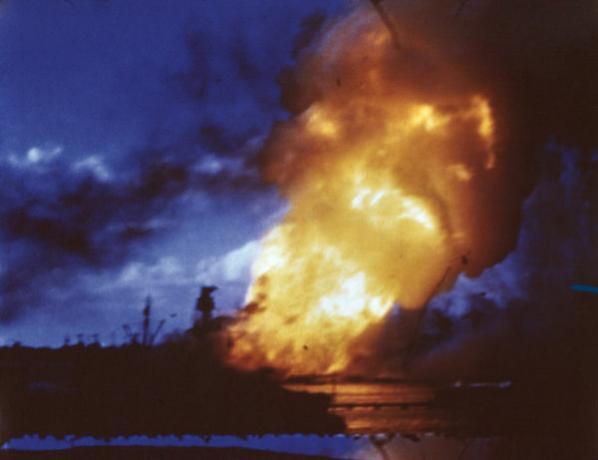The Asia and Pacific war scenarios during the Second World War put the Japan against American, British and Australian troops mainly. Japan's conflict against these nations started in 1941, but since 1937 Japanese were already at war with China (Second Sino-Japanese War). The attack on Southeast Asia was part of Japan's territorial expansion project. The purpose of this text is to cover only the first part of this war scenario marked by Japan's quick victories in Southeast Asia.
Attack on Pearl Harbor

Digitally colored image of the Japanese attack on the US naval base at Pearl Harbor in December 1940
Throughout the 1930s, Japan's political and intellectual elite championed militarism as a way to ensure the defense of its internal interests. In this context, the war against the United States was openly defended by the country's military leadership. Furthermore, Japan had a number of imperialist interests over its Asian neighbors.
Japan's entry into World War II officially took place from the
attack on the naval base at Pearl Harbor on December 7, 1941. The Japanese attack took place without a formal declaration of war and was aimed at the total destruction of the American Pacific Ocean fleet. This, however, did not happen, as the attack on Pearl Harbor managed to only partially destroy the American fleet. The result was a balance of more than two thousand dead Americans.Attack on Southeast Asia
Japan's next step was to take the war to Southeast Asia, in the British colonies in the region. Before that, in 1940, Japan had invaded the French Indochina with the aim of closing a route for sending weapons to the Chinese rebels. Japan's objective in Southeast Asia was to drive out British and American colonial forces to ensure control over material resources in that region.
British troops in Southeast Asia were extremely ill-equipped, and the war showed that they were also ill-prepared and poorly led. The best British troops had been deployed in Europe and the Middle East. This resulted in a total failure of British forces when the Japanese attacked the region from December 1941.
Japan had quick victories in Singapore, Malaysia and HongKong and formed troops extremely well prepared for the conflict. Thus, they covered large swaths of land per day and had a good ability to penetrate the region's jungle. This gave them a big advantage over British troops, who didn't know how to fight in the rainforest. Accounts of the battles at these three locations are full of flight and veritable disorder in British defenses.
Do not stop now... There's more after the advertising ;)
After securing control over Singapore, Malaysia and Hong Kong, Japan went on the attack from the Dutch East Indies (current Indonesia). The region was controlled by the Netherlands and, during the confrontation, had the support of the Allies (group formed by the United States, the United Kingdom and the Soviet Union that fought against the Axis, formed by Germany, Italy and Japan).
The dispute in the Dutch East Indies took place mainly over the island of Java (the largest Indonesian island). The Dutch naval fleet was defeated by the Imperial Japanese Navy in February 1942, and in March Japan secured control over the region. The great importance of the Dutch East Indies was the great oil reserves.
The biggest dispute in the Japanese attacks on Southeast Asia took place in the Burma battle. British resistance in the region lasted 127 days after the first attack, which took place on December 23, 1941. Despite this, the scenario in Burma was no different: defenses that were poorly prepared and easily dispersed by Japanese attacks. Japanese aviation attacks were important to dismantle the fragile British defense in the region.
In approximately six months, Japan had conquered a large swath of land and secured control over important sources of natural resources, mainly oil reserves (there were no oil reserves in the Japan). The losses in equipment and soldiers were very small, and the speed of victories was unexpected.
With the installation of Japan in the region, reports of violence and brutality portrayed the reality of Japanese domination. The Japanese army had an institutionalized violence that spared neither prisoners of war nor civilians. Countless prisoners were executed, and civilians suffered numerous abuses, such as mass rapes carried out by Japanese soldiers.
Continuity of War: Conclusion
The continuation of the war saw the total decline of the Japanese army. This decline, however, came slowly, as the Allies had to pay a high price for each new conquest. Japan's quick victory in Southeast Asia reinforced Japan's war propaganda, which conveyed the vital importance of the war and the invincible character of the Japanese army. Overjoyed, the Japanese people literally fought to the death in every region in Asia.
The victories, however, made it difficult to see a relevant fact: the Japanese inferiority in relation to the United States. The voices against the war, in addition to being persecuted, were drowned out by the quick victories. History has shown that Japan had neither the financial capacity nor the human material to maintain a long-term war against the United States and its mighty economy.
by Daniel Neves
Graduated in History
Would you like to reference this text in a school or academic work? Look:
SILVA, Daniel Neves. "Japanese victories in WWII"; Brazil School. Available in: https://brasilescola.uol.com.br/historiag/vitorias-japonesas-na-segunda-guerra-mundial.htm. Accessed on July 27, 2021.
